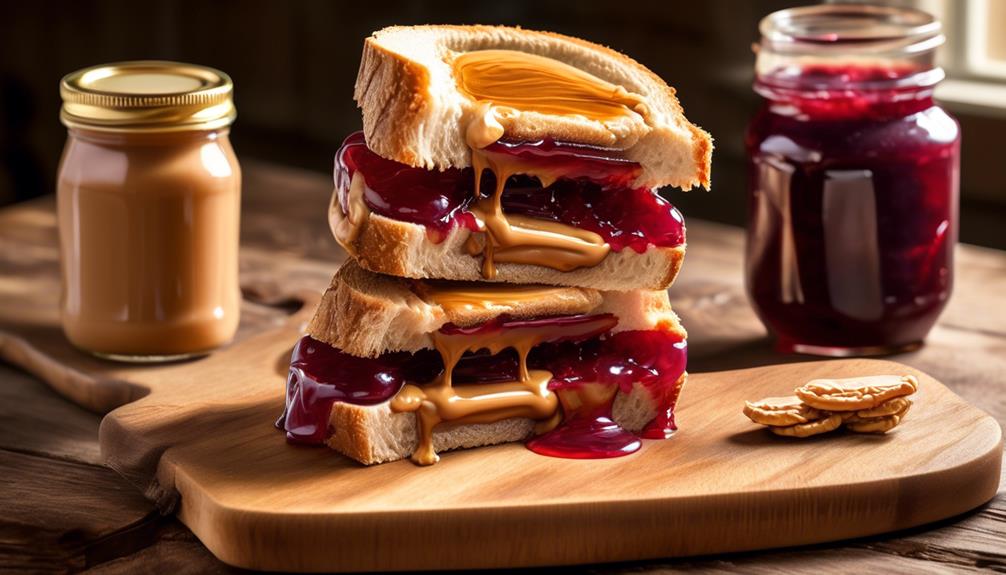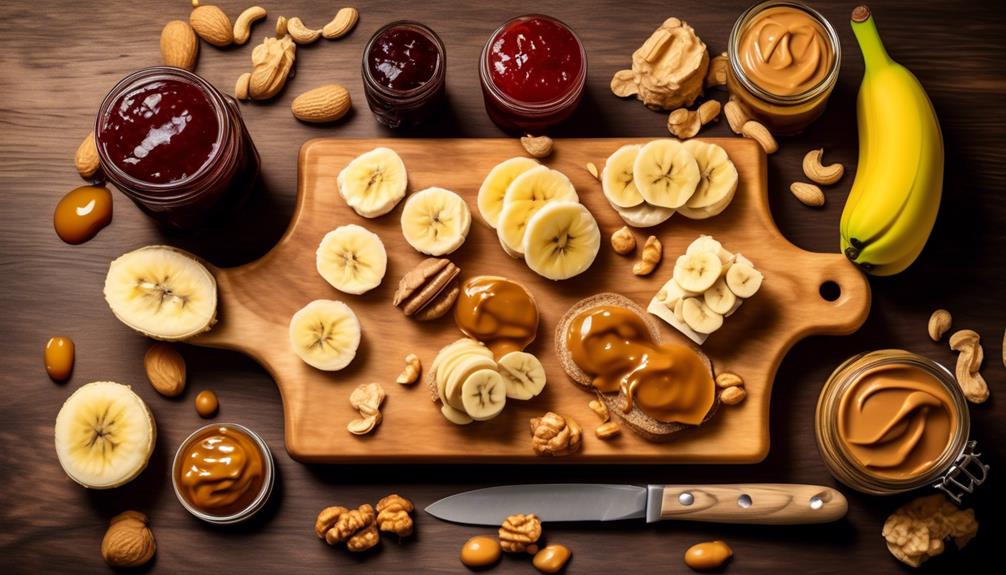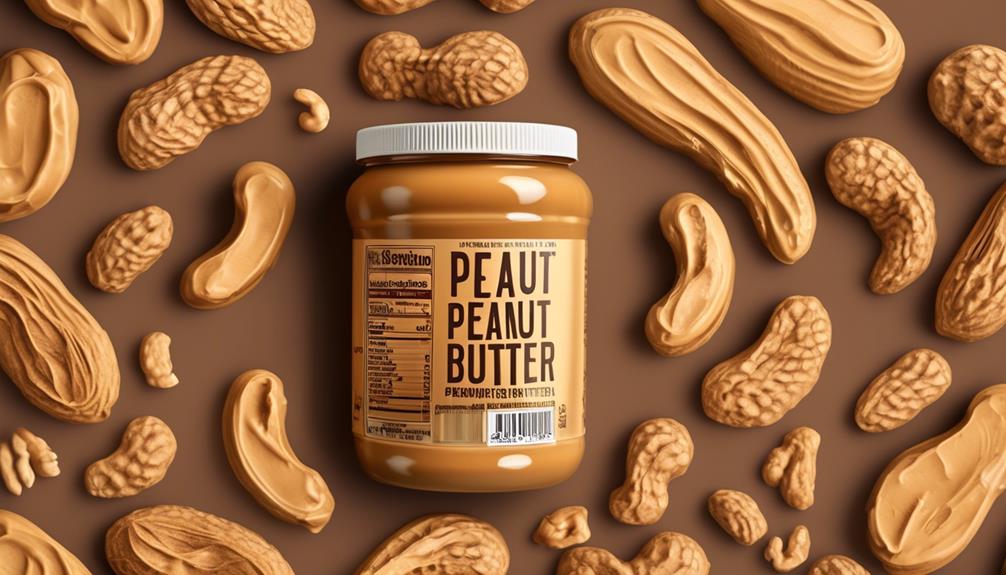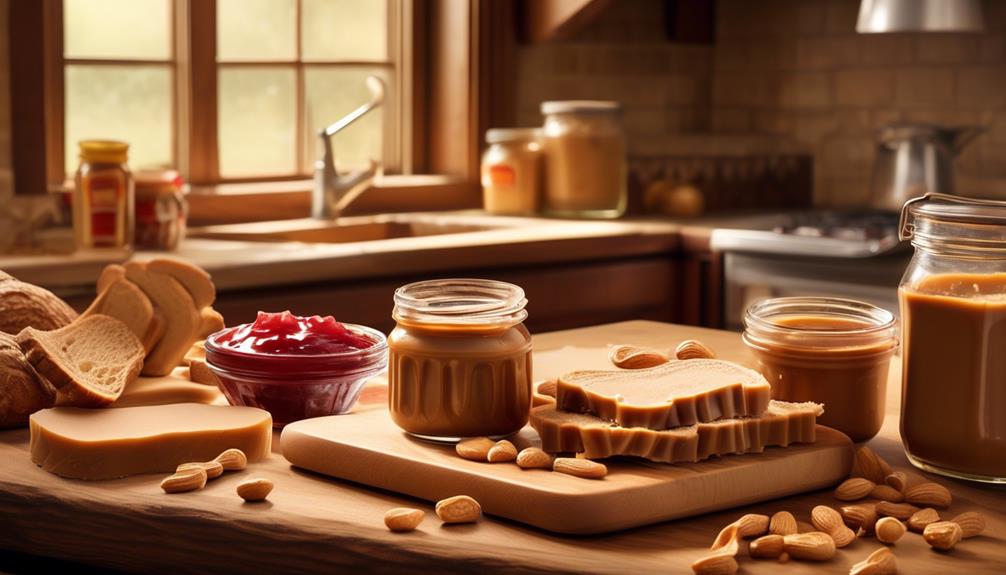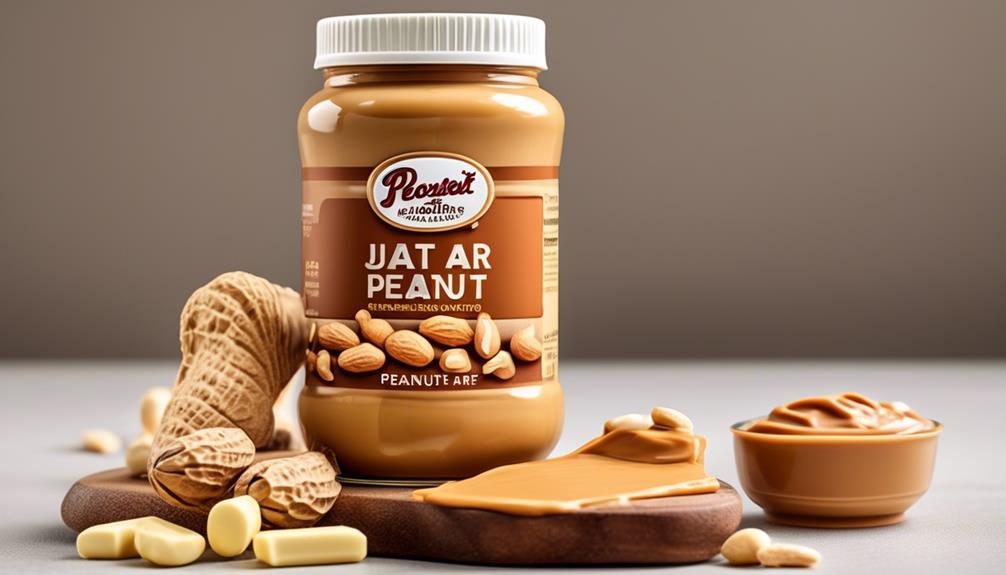We have all enjoyed the delightful experience of taking a bite out of a well-made peanut butter and jelly sandwich – the smooth peanut butter mixing perfectly with the sweet, fruity jelly nestled between two slices of soft bread.
But have you ever stopped to wonder why this particular combination is so beloved by millions?
The history and cultural significance of peanut butter and jelly reveal intriguing insights into its enduring popularity, from its humble beginnings to its impact on American cuisine.
So, what exactly makes peanut butter and jelly the iconic duo it is today?
Key Takeaways
- Peanut butter and jelly sandwiches have a rich history and cultural significance in American society, dating back to the late 19th century.
- The distinct flavor profile of PB&J, with its combination of creamy peanut butter and sweet jelly, is nostalgic and familiar to many.
- PB&J sandwiches offer health benefits, providing a balanced meal with protein, healthy fats, and essential nutrients.
- There are numerous recipe variations for PB&J, allowing for customization and catering to different dietary preferences.
History of Peanut Butter and Jelly
The history of the peanut butter and jelly sandwich is a fascinating journey that intertwines the evolution of culinary trends, wartime influences, and economic hardships in the United States.
Peanut butter, initially introduced at the 1893 Chicago World Fair, gained popularity as a nutritious and affordable food item. It made its way into upscale tea rooms and eventually found its place in the iconic sandwich.
Meanwhile, jelly was popularized by American troops in WWI, leading to its common use as a spread for sandwiches, including the peanut butter and jelly sandwich.
The Great Depression further solidified the sandwich as a popular and affordable meal, as it provided sustenance during challenging economic times. Additionally, the invention of the sandwich and pre-sliced bread revolutionized the way people ate meals, laying the foundation for the peanut butter and jelly sandwich's widespread appeal.
This culinary history has deep roots in American culture, with the sandwich remaining a favorite among families and students on a budget due to its convenience, affordability, and nostalgic appeal. The peanut butter and jelly sandwich continues to be a beloved staple in American cuisine, showcasing the enduring impact of historical events on food trends.
Flavor Profile of PB&J

After exploring the historical significance of the peanut butter and jelly sandwich, we can now examine the flavor profile of this classic combination.
The PB&J sandwich has a distinct flavor profile that's a delightful mix of sweet and savory. The creamy, nutty taste of peanut butter pairs seamlessly with the fruity and tangy flavor of jelly. This harmonious blend creates a comforting and indulgent taste experience. Peanut butter contributes a creamy texture and a slightly salty, roasted peanut flavor, while the jelly adds a burst of sweetness and fruitiness. The combination of these flavors is nostalgic and familiar, making it a beloved comfort food for many.
The flavor profile of PB&J isn't only timeless but also versatile, allowing for various interpretations and innovations. Different types of nut butters, jams, and jellies can be used to create unique taste experiences while still capturing the essence of the classic combination. This versatility has contributed to the sandwich's enduring popularity and its ability to adapt to different culinary preferences, ensuring its place as a cherished staple in many households.
Cultural Significance of PB&J
With its deep-rooted historical origins and widespread adoption across diverse socioeconomic backgrounds, the cultural significance of PB&J is undeniable. The peanut butter and jelly sandwich appeared in the early 1900s and quickly gained popularity as a convenient and affordable meal, making it an integral part of American culinary history.
| Culinary History | Cultural Significance |
|---|---|
| First Two Schools | The first mention of a peanut butter and jelly sandwich was in 1901 by Julia Davis Chandler in the "Boston Cooking-School Magazine of Culinary Science and Domestic Economics." This marks its early presence in American cuisine. |
| National Peanut Board | The National Peanut Board recognized the PB&J's cultural importance by designating April as "National Peanut Butter and Jelly Month." It represents a staple in American diets, with its significance celebrated annually. |
| History of the Goober | The rise of the peanut butter and jelly sandwich during the Great Depression and its inclusion in the U.S. Military ration menus in World War II cemented its position as a symbol of affordability and accessibility, contributing to its cultural significance. |
The PB&J has transcended its humble origins to become a symbol of comfort, nostalgia, and unity, connecting people across generations and backgrounds. Its cultural significance lies in its ability to bridge economic gaps and serve as a unifying culinary tradition in American society.
Health Benefits of PB&J

Having established the cultural significance of PB&J as a unifying culinary tradition, delving into its health benefits reveals its potential as a balanced and nutritious meal option.
Peanut butter, a staple of the American diet, is a good source of protein, healthy fats, and essential nutrients like magnesium and potassium. It contributes to satiety and helps in maintaining stable blood sugar levels.
Jelly, often made from fruits rich in antioxidants, provides natural sweetness and is a source of vitamins and minerals essential for overall health.
The combination of peanut butter and jelly in a sandwich creates a balanced meal with carbohydrates, protein, and healthy fats. This makes it a convenient and quick, satisfying snack or meal, especially in the context of busy schedules and hectic lifestyle.
Moreover, the versatility of peanut butter and jelly allows for various substitutions and combinations to suit different dietary preferences and tastes, making it a favorable option for school lunches and beyond.
Considering its nutritional value and ease of consumption, the peanut butter and jelly sandwich continues to be America's favorite, representing a harmonious blend of taste and health benefits.
Recipe Variations for PB&J

A multitude of inventive recipe variations can elevate the classic PB&J sandwich, offering diverse flavors and textures to suit individual preferences and culinary explorations.
By substituting honey or sliced fruit for the jelly component, one can create a different flavor profile for their PB&J sandwich, adding a natural sweetness and a unique twist.
Another option is to use marshmallow fluff instead of jelly, resulting in a delightful Fluffernutter sandwich.
For those seeking a different nutty taste, almond butter and jelly sandwiches present an exciting alternative. Moreover, exploring other nut butter options, such as sunflower seed butter, can add variety and cater to different dietary preferences.
Additionally, using cream cheese or Nutella as alternative spreads offers a departure from the traditional PB&J flavors, creating a delectable and rich experience.
These variations showcase the versatility of the PB&J sandwich, allowing for endless creativity and personalization in culinary endeavors.
Whether it be through different spreads, fruits, or nut butter choices, the PB&J sandwich provides ample room for experimentation and enjoyment.
Frequently Asked Questions
Why Is Peanut Butter and Jelly a Thing?
We can understand the popularity of peanut butter and jelly by considering its historical context. The convenience of a one-handed meal and the availability of ingredients like peanut butter, jelly, and pre-sliced bread contributed to its rise.
During hard times like the Great Depression and World War II, it became a staple. However, societal changes in the 1990s led to a decline in its popularity, with concerns about processed foods and allergies playing a role.
Why Do Americans Eat Peanut Butter and Jelly Sandwiches?
We eat peanut butter and jelly sandwiches for their convenience and comforting taste. They've become a staple in American households due to their one-handed nature and widespread availability.
The sandwich's popularity can be linked to historical events like the Great Depression and World War II, when it became an affordable and widely consumed meal. It symbolizes comfort and nostalgia, making it a beloved choice for many Americans.
When Did Pb&J Become a Thing?
In the early 1900s, peanut butter and jelly became a thing as a budget-friendly, convenient meal option. The combination gained popularity among families and students during the Great Depression and World War II.
It was further facilitated by the availability of pre-sliced bread and industrialization. As a result, it became a quintessential American meal in the twentieth century.
What Does the Peanut Butter and Jelly Symbolize?
Peanut butter and jelly symbolize convenience, affordability, and accessibility. The sandwich's popularity during times of economic hardship reflects its ability to provide a satisfying meal with minimal resources.
It also represents the industrialization of food production, as pre-sliced bread and commercially produced spreads made it widely available.
Additionally, PB&J's enduring status in American cuisine is reflected in the various creative variations that have emerged over the years.
Conclusion
In conclusion, the history, flavor profile, cultural significance, and health benefits of peanut butter and jelly sandwiches have made them a beloved and enduring meal option.
Like a classic melody that never goes out of style, the combination of peanut butter and jelly continues to resonate with people of all ages, reminding us that simple pleasures can withstand the test of time.
So, whether you prefer grape or strawberry jelly, or crunchy or smooth peanut butter, the PB&J sandwich will always be a timeless favorite.
